Klue Compete
The Competitive Enablement Platform
Learn More
INTRODUCING KLUE INSIGHTS
FIND OUT MORE >

You can split sources of competitive intelligence into two giant buckets: internal and external.
As the names would suggest, external intel relies on sourcing data from publicly available forums.
Conversely, internal sources of competitive intelligence come from and within your organization’s four walls.
Turning that intel into insights takes a different set of tools altogether. But finding the right sources of competitive intelligence is a crucial step in conducting competitive intelligence research and building a compete program that helps your business win more.
Here are ten of the most valuable sources of competitive intelligence you should know about.


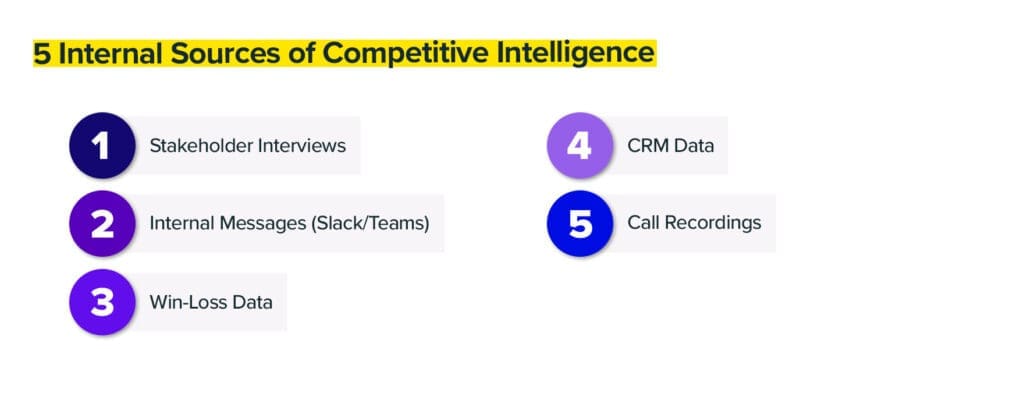

Whether your competitive enablement program is in its humble beginnings or fully fleshed out, interviewing and surveying your internal stakeholders will always be a primary source of competitive intelligence.
These stakeholder interviews are so important that Tracy Berry, Director of Competitive Intelligence and Communication at Freshworks, makes them an essential part of any compete program she builds. She calls them the 30-in-30 interviews, where she talks to thirty key stakeholders for thirty minutes each.
“I use interviews to help me understand, to get my fingers on the pulse of competitive in the company. And that helps me really set the priorities I need to establish the function.”
— Tracy Berry, Director of Competitive Intelligence and Communication, Freshworks
Regular interviews with your stakeholders and the data you draw from them will always be one of the most important sources of competitive intelligence.
The time you spend conducting interviews and analyzing the results will help you:
If you’re just starting out with competitive intelligence, then you can also conduct a Competitive Confidence Survey. This allows you to interview y and collect competitive intel at scale, prioritize competitors, and find quick wins. You can get started with our own Competitive Confidence Survey template here.


If your company doesn’t have a dedicated competitive intel channel, you need to stop everything and create one.
According to virtually every compete professional we talk to, internal messaging channels are an absolute goldmine when it comes to sources of competitive intelligence. It allows you to collect information at scale, and provides an easy place for your stakeholders to share what they’ve seen or heard.
Perhaps unsurprisingly, Klue’s Competitive Enablement Manager Brandon Bedford is a proponent of leveraging internal messages for intel.
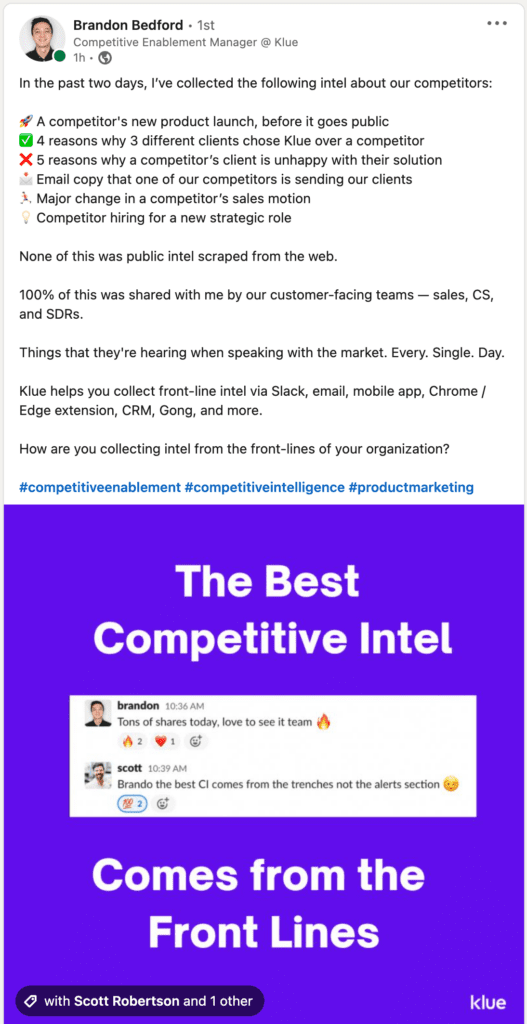

Companies that establish a culture of compete, in which reps are readily sharing competitive intelligence, have a leg up on those that don’t.
Create a #competitiveintel channel in your internal messaging platform and start building that culture today.
How to use this source of competitive intelligence:
This source of competitive intelligence gives you a window into what is happening in customer-facing interactions across the business. With a #competitiveintel channel, you’ll be able to collect intel that isn’t easily accessible through external sources; like pricing strategies, common objections, real-time buyer feedback.
BUT REMEMBER! You cannot just take your stakeholder’s word as gospel. Make sure you verify what gets shared in the channel.
Despite our great love of internal stakeholder interviews, gathering competitive intelligence via this method has its limitations.
Namely because third-party objective data almost always trumps subjective hunches.
Whether you’re using an agency, contractor, or have a sophisticated in-house program, win-loss interviews help uncover valuable insights about why a prospect decided to pick your solution or a competitor’s.
“Win-loss interviews offer an unparalleled opportunity to get honest, straightforward feedback from people who have been immersed in studying up on the similarities between you and your competitors.”
— Ryan Sorley, VP of Win-Loss at Klue.
From Interview to Insights: Learn how to establish win-loss analysis
Firstly, this source of competitive intelligence is straight from the buyer’s mouth; that in and of itself is invaluable for your revenue teams.
A few tactical ways you can use this source of intel:
You can also be highly targeted with this source and informs strategic initiatives. For example, your internal data may flag that 75%+ of deals are dropping at a specific stage in the sales cycle, let’s say after the initial demo call.
With this understanding, you can target win-loss interview questions on the accounts that dropped off after that first demo and dig into the what, why, and how. This allows you to provide even more direct and informed insights that can help your sales team fix that initial demo process.
Starting win-loss analysis for the first time? Grab our guide to learn how to conduct win-loss interviews, and our win-loss template for sharing the findings with your leadership team.


If reading the words ‘CRM data’ made you shudder… you’re not alone. Nearly everyone handling competitive intelligence deals with dirty CRM data.
However, it is arguably the most valuable source of competitive intelligence once you’re able to clean it up.
How you can use this source of competitive intelligence:
There’s a million-and-one things you can learn from CRM data when using it as a source of competitive intelligence.
One example that we use with our customers at Klue is conduct a threat analysis. This means:
Doing these three things allows you to credibly quantify your competitive revenue gap for each competitor.
Not only does this help you prioritize what competitors to focus your efforts on, but it allows you to clearly show your leadership team the revenue impact each competitor currently has on your business.
Now, once you start tipping some of those neck-and-neck deals your business’ way, you can report and prove the revenue impact of your competitive enablement program.
Use our Competitive Revenue Gap calculator today, and grab this template for building an action plan to close the gap.


The gold standard of battlecard content is real, proven talk tracks your reps are already using.
As such, call recordings are excellent sources of competitive intelligence because they give you direct insight into how your messaging is landing.
These insights then allow you to shift and adjust your messaging and positioning as necessary.
And as a compete pro, analyzing call recording sets you up to enable your reps better since you’ll begin to understand what’s resonating and what isn’t.
If you’re using conversational intelligence software, collecting this source of competitive intelligence can be as simple as setting an alert every time your competitor is mentioned on a call. If you’ve got competitive intelligence software, then all of those mentions can sit in one central place for you to sink your teeth into!
Taking intel from call recordings, drawing insights from them, and enabling your team to win more deals is the true essence of competitive enablement.
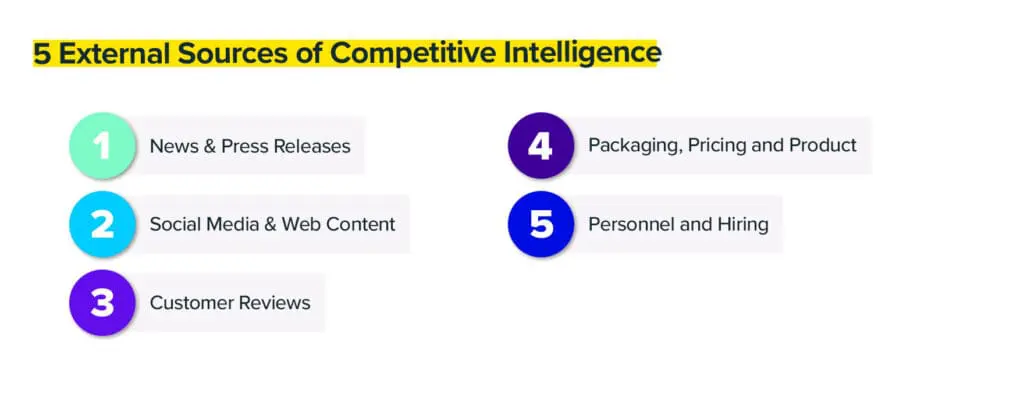

One of the most accessible sources of competitive intelligence to build a full profile on your competitors is through their news, events, and press releases.
These timestamped pieces of content can help piece together the story of where they’re headed, and what they value.
What intel is important?
A company’s press release page is a strong indicator of what they want current and potential customers to care about.
Did your competitor only mention enterprise customers during their funding announcement? That might be fishy if they’ve typically been a competitor within smaller deals.
These announcements are a tool for competitors to position themselves. Tools that might introduce new funding and partnerships, product advancements, or suggest that a business is scaling up.
Competitor blog articles, social posts, podcasts, videos, e-books, case studies and white papers (oh my!), are all sources of competitive intelligence your company should be monitoring.
Now more than ever, companies produce content for branding and industry positioning purposes.
Thus, frequently checking a competitor’s content production will help you build out your own strategy.
How regularly are they posting blogs? What are the main topics they’re trying to ‘own’? What calls-to-action are they embedding in their content?
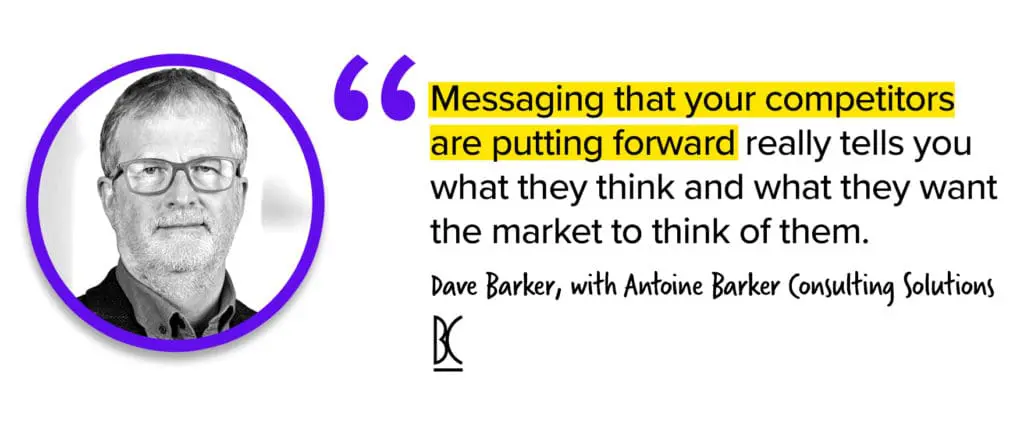

Most importantly, how can you take advantage of the knowledge gaps in your competitor’s content by filling them yourself?
According to Dave Barker, when combined with PR and news monitoring, messaging in competitor web and social media content “really tells you they think and what they want the market to think of them.”
Ultimately, understanding how your competitor wants to be seen by the market helps you position against them more effectively.
A competitor’s products and offerings are essential — if not obvious — sources of competitive intelligence.
At the end of the day, you need to know how you stack up.
And knowing everything about your competitors arms your reps with the actionable information needed to close a competitive deal.
But, it isn’t just the sales team that benefits from this. Every department across the organization can leverage information on competitor solutions, and how their pricing changes over time.
Finding a competitor’s most common FAQs and support threads sheds light on their user experience (UX). More, they aggregate the main issues affecting those using the product.
Beyond that, analyst reports by Forrester, Gartner, and IDC can help you understand your competitors in a variety of ways.
They analyze strategy, market presence, and other criteria for groups of products within a particular category.
Pro-tip: Using Google’s advanced search is a sneaky trick to find details that a competitor doesn’t highlight prominently on their website.
Here you may find product and user guides that are intended for sales reps or customers; they are far more detailed than public-facing feature lists and offer insight into a product’s roadmap and positioning.
Becoming familiar with your competitor’s personnel strategy reveals their current needs and where they might be headed.
For example, looking at a competitor’s hiring trends is a great way to forecast their next move.
Make sure to scratch beneath the surface of these job postings:
These insights don’t just indicate a competitor’s growth, but also provide a glimpse into their strategic plan.
Personnel changes at the C-suite level are also strong indicators of a strategic shift.
A new member of the executive team with a background that differs from their core business may portend a change in strategy.
P.S. looking for a cheeky way to use this source of competitive intel? Nick Larson, Sr. Product Marketing Manager at Staffbase, mentioned during his appearance on the Competitive Enablement Show that he loves including awful Glassdoor reviews on their competitors within his competitive intelligence newsletter.
Customer reviews dominate the internet. For better or worse, customers’ opinions left on review websites is the most essential way to establish your company’s credibility.
Conversely, they’re a great resource for getting the inside scoop on a competitor.
For instance, tracking negative user feedback is a great method to enable your sales team for future deals. With a thorough understanding of a competitor’s weaknesses, you can deposition them by ‘laying a landmine’ or using a quick dismiss.
When you have a handle on customers’ most common pain points, you can start sowing the seeds of doubt early on in the deal cycle.
And beyond product review sites, consider employer reviews like Glassdoor as an additional source of intel.
Even the best intel in the world won’t help you win more deals.
The data you get from these sources of competitive intelligence can’t be activated unless you enable your team with it.
You need to take that intel and turn it into insights. Insights that direct your company’s overarching strategy and reach your reps in the exact moments they need them.
The way companies compete today is broken — and we’re here to fix it. We call it competitive enablement. If you’re looking for tactical steps to launch competitive enablement effectively, check out our full guide with nine steps that you can nail today.
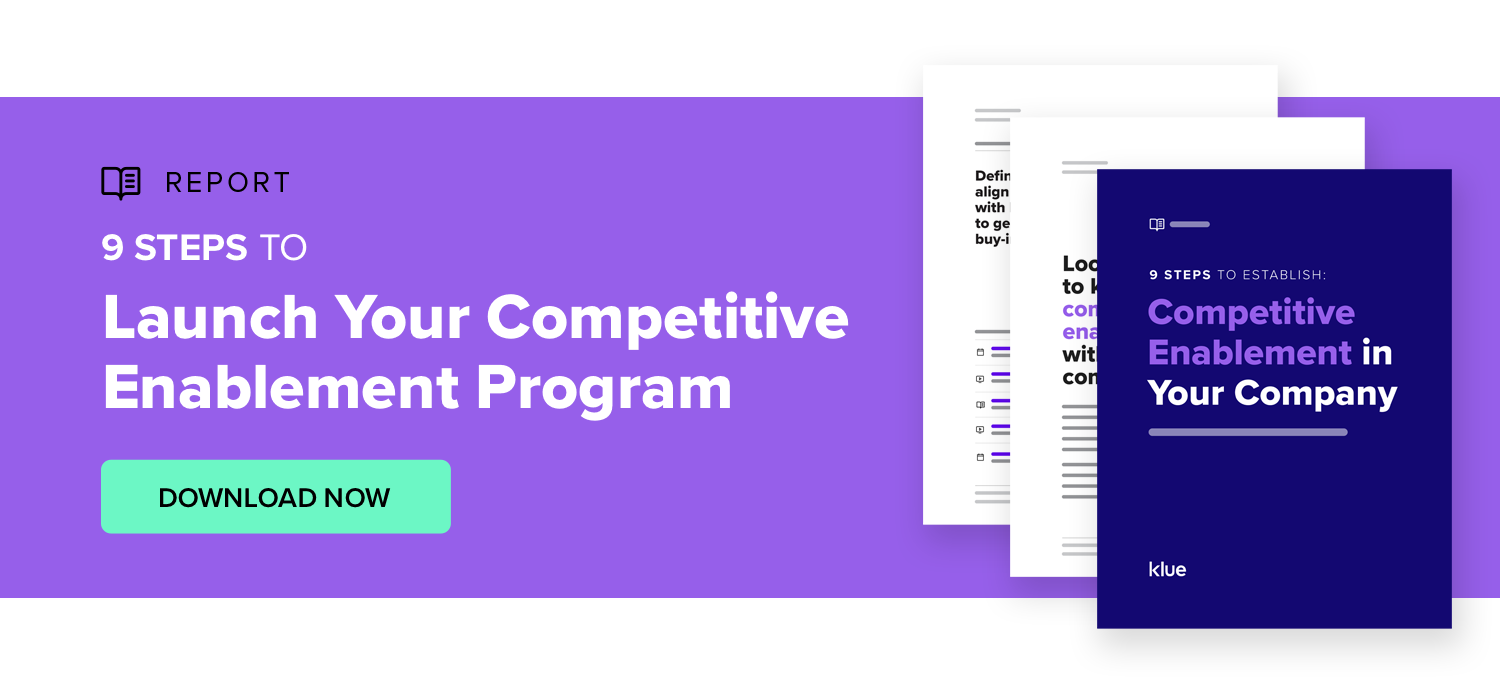



Competitive Enablement
The topic of Large Language Models (LLMs) has a lot of confusion. Here's what you need to know about how Klue is working with them.


Competitive Enablement
Product Marketing
If your competitive intel game is too strong for automation, too pure for data privacy, and too rebellious for accuracy — then Klue AI is probably not for you.


Let’s do it. Tell us a bit about yourself and we’ll set up a time to wow you.
Let's do it. Tell us a bit about yourself and we'll set up a time to wow you.
XLet's do it. Tell us a bit about yourself and we'll set up a time to wow you.
XSubscribe to get our latest AI functionality and news in your inbox.
XOur Buyer Pulse feature, set to launch in Q2 2024, offers valuable insights into the factors influencing buyer decisions in your pipeline. By signing up for the waitlist, we can better gauge interest and proactively engage with you to streamline the setup and integration process before the feature becomes widely available.
X